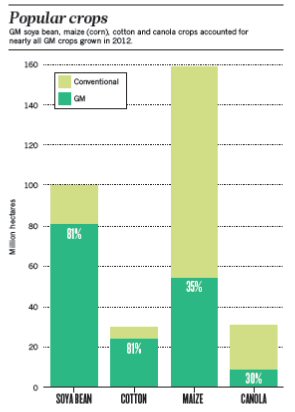While the EU struggles to define its policy on the cultivation of GM crops, the area under GM varieties globally continues to grow. Recent data from the ISAAA show that the total global area planted to biotech crop varieties in 2013 reached 175 million hectares for the first time. As 1996 was the first year in which genetically-modified crops were commercialised on a significant scale (the first GM crop planted was tomatoes in 1994), supporters of the technology point out that this rate of expansion makes biotech crops the fastest adopted crop technology in recent history.
Of the 27 countries which planted biotech crops in 2013, 19 were developing and 8 were industrialised countries. Latin American, Asian and African farmers collectively grew 94 million hectares or 54% of the global 175 million biotech hectares compared with industrialised countries at 81 million hectares or 46% of the total.
Just four major GM crops dominate the market: soybean, cotton, maize and canola (rape). In terms of the share of the total area cultivated, soybean and cotton are the most successful GM crops. In 2012, more than four-fifths (81%) of the total area of these crops grown globally were GM varieties. In the case of maize, over a third (35%) of the 158 million hectares of globally grown maize was GM and 30% of globally grown canola (with a total area of 31 million hectares).
The two dominant agronomic traits currently available are herbicide tolerance (HT) and insect resistance (mostly in the form of Bt crops). Herbicide tolerance is the prevailing trait that is deployed in all four dominant crops, while maize and cotton are the only two insect resistant GM crops currently commercially available. Varieties with stacked traits (containing more than one novel gene) are becoming increasingly popular.
High adoption rates
Claims are sometimes made that GM crops do not yield economic benefits but these claims are not supported by the evidence on adoption rates in those countries where GM crops have been approved for cultivation.
For example, US data show that HT (herbicide-tolerant) soybeans are now grown on 93% of US soybean acreage. Plantings of HT cotton expanded from about 10% of US acreage in 1997 to 82% in 2013 while Bt cotton was grown on 75% of the area. HT maize accounted for 85% of US corn acreage in 2013. In fact, full 100% adoption is not necessarily a desirable outcome because refuge areas planted to non-GM varieties can play an important role in slowing down the evolution of resistant weeds and pests and are often required by the regulatory authorities. Biotech canola in Canada enjoyed a high adoption rate of 96% in 2013 while in Australia adoption remained at a high of 99%.
High adoption rates for GM varieties are also found in developing countries. India cultivated a record 11.0 million hectares of Bt cotton with an adoption rate of 95% in 2013, whilst 7.5 million small farmers in China grew 4.2 million hectares of Bt cotton with an adoption rate of 90%, cultivating on average ~0.5 hectare per farm. Burkina Faso, which approved Bt cotton for planting in 2008, has seen a huge increase in the area planted; over 50% of its cotton area was planted to Bt cotton in 2012, and this area increased by over 50% in 2013.
Last month, European and African science academies held a workshop in Addis Ababa exploring the current status and potential of agricultural biotechnologies for Africa. The keynote address at that conference by Professor Martin Qaim provides a very good overview of the economic and social benefits of current GM crops especially in developing countries.
Implications for EU policy
EU policy on approvals of GM crops for cultivation has been totally deadlocked between those willing to follow the science-based assessment of EFSA and a majority of member states which remain opposed to allowing the cultivation of GM crops under any circumstances. There appeared at the March 2014 Environment Council meeting to be some movement on the Greek Presidency’s reintroduction of the Commission proposal to allow individual member states to restrict the cultivation of GM crops already assessed and approved by EFSA on health and environmental grounds on other criteria, including socio-economic criteria. It now appears that the Council could reach a common position on this proposal by June, although the European Parliament rapporteur, Corinne Leparge, has called the Commission text weak and has warned of difficult negotiations with the Parliament.
European policy on this issue is driven by a volatile mixture of beliefs, risk perceptions and socio-economic interests which is increasingly damaging to longer-term EU interests in a competitive agriculture and a sustainable food supply. The EU risks becoming increasingly uncompetitive on international markets while research and innovation is driven abroad.
European policy means that the benefits of the new technology accrue to other countries which can then sell the products back to EU member states. The overwhelming scientific evidence and consensus, reflected in reports of national, European and US science academies and science organisations (see lists of references here and here), is that appropriately-regulated GM crops are just as safe, from both health and environmental perspectives, as conventionally-bred crops.
Nonetheless, European public opinion (last surveyed in 2010 by Eurobarometer) does not see benefits in genetically modified food, considers genetically modified foods to be probably unsafe or even harmful and is not in favour of development of genetically modified food. While the stated opinions of consumers are often at variance with their purchasing habits and GM foods are not at the top of the list of consumer concerns about their food, there is undoubtedly a failure here of policy and science communication.
As a result, while much of the rest of the world embraces GM technologies with their economic, health and environmental benefits, Europe continues to flounder. From the perspective of science-based regulation, the Commission proposal which would allow member states to ban the cultivation of GM crops on non-scientific grounds is a backward step. However, it recognises the current reality and, by restoring the ultimate decision on GM cultivation to national parliaments, it may provide the opportunity for a more informed and less inflamed debate on the merits of GM technologies in improving our food supply.
This post was written by Alan Matthews.
Photo credit: Wikipedia used under a Creative Commons licence.

Alan Matthews is Professor Emeritus of European Agricultural Policy in the Department of Economics at Trinity College, Dublin, Ireland. His major research interests are agricultural policy analysis, the impact of international trade on developing countries, and computable general equilibrium analysis of trade and agricultural policy reforms. He has worked as a consultant to the European Parliament, the OECD, the Food and Agricultural Organisation of the United Nations and the UN Industrial Development Organisation, and has been a panel member in a number of WTO Dispute Settlement procedures. He is currently President of the European Association of Agricultural Economists but writes here in a personal capacity.
This article is republished with the permission of the author, Prof Matthews. It has been faithfully reproduced and not edited in any way. Notwithstanding that Prof Matthews does not necessarily endorse the Global Farmer in which it now appears.


